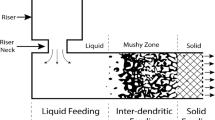The first technology for quasi-isostatic pressing that does not use costly isostatic presses has been developed in Russia. The pressing operation is performed in quasi-isostatic molds on conventional hydraulic or mechanical presses normally used for static pressing. This article examines the advantages that quasi-isostatic pressing has over hydrostatic and static pressing.


Similar content being viewed by others
References
M. I. Timokhova, Investigation of Certain Factors in the Hydrostatic Pressing of Electroceramic Products. Author’s Abstract of Engineering Sciences Candidate Dissertation. Maria Ivanovna Timokhova, Moscow (1964).
M. I. Timokhova, “Quasi-isostatic pressing of ceramic products,” VNIIESM, Moscow (1990). Series 5. Keramicheskaya Promyshlennost’, No.1, 1–68.
M. I. Timokhova, “Physical foundations of the quasi-isostatic pressing of powdered materials,” Novye Ogneupory, No. 12, 12–17 (2009).
N. S. Kostyukov and M. I. Timokhova, “Isostatic pressing of products without an isostatic press,” Steklo i Keramika, No. 2, 16–18 (1981).
M. I. Timokhova, “Design specifics of quasi-isostatic molds,” Refractories and Industrial Ceramics, 47, No. 6, 344–347 (2006).
M. I. Timokhova, “Production schemes for quasi-isostatic compaction of ceramic objects,” Refractories and Industrial Ceramics, 50, No. 4, 262–265 (2009).
M. I. Timokhova, “Development stages and introduction into series production of a quasi-isostatic production method,” Refractories and Industrial Ceramics, 50, No. 5, 340–343 (2009).
M. I. Timokhova, “ Industrial technology for the automated production of grinding balls by quasi-isostatic pressing,” Refractories and Industrial Ceramics, 52, No. 6, 389–392 (2011).
M. I. Timokhova and V. S. Rachkov, “Quasi-isostatic pressing of saggers,” Steklo i Keramika, No. 5, 17–19 (1991).
M. I. Timokhova, “Certain types of defects in the pressing of ceramic products,” VNIIESM, Moscow (1990). Series 5. Keramicheskaya Promyshlennost’, No. 1, 1–68.
M. I. Timokhova, “Phenomenon of an elastic after-effect with quasi-isostatic compaction and compact defects,” Refractories and Industrial Ceramics, 49, No. 6, 426–431 (2008).
Author information
Authors and Affiliations
Additional information
Translated from Novye Ogneupory, No. 6, pp. 24 – 28, June, 2012.
Rights and permissions
About this article
Cite this article
Timokhova, M.I. Advantages of quasi-isostatic pressing for powder materials. Refract Ind Ceram 53, 147–150 (2012). https://doi.org/10.1007/s11148-012-9483-5
Received:
Published:
Issue Date:
DOI: https://doi.org/10.1007/s11148-012-9483-5




